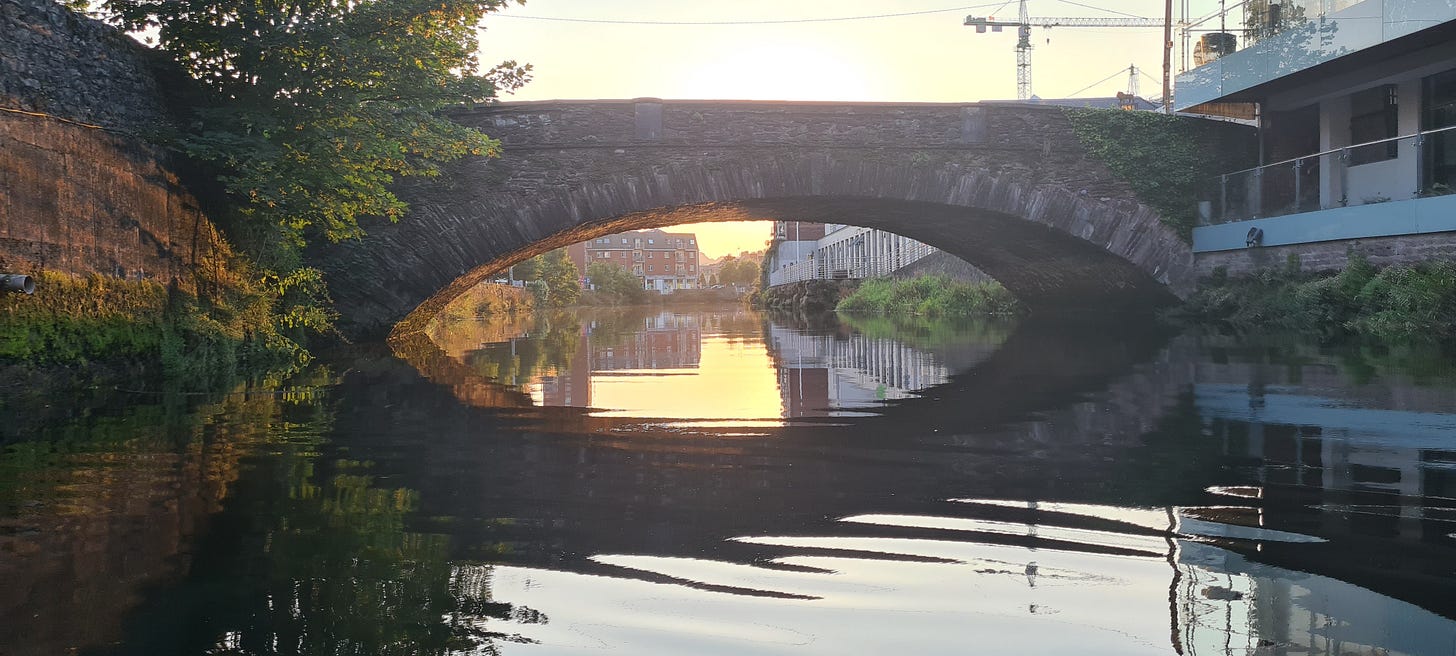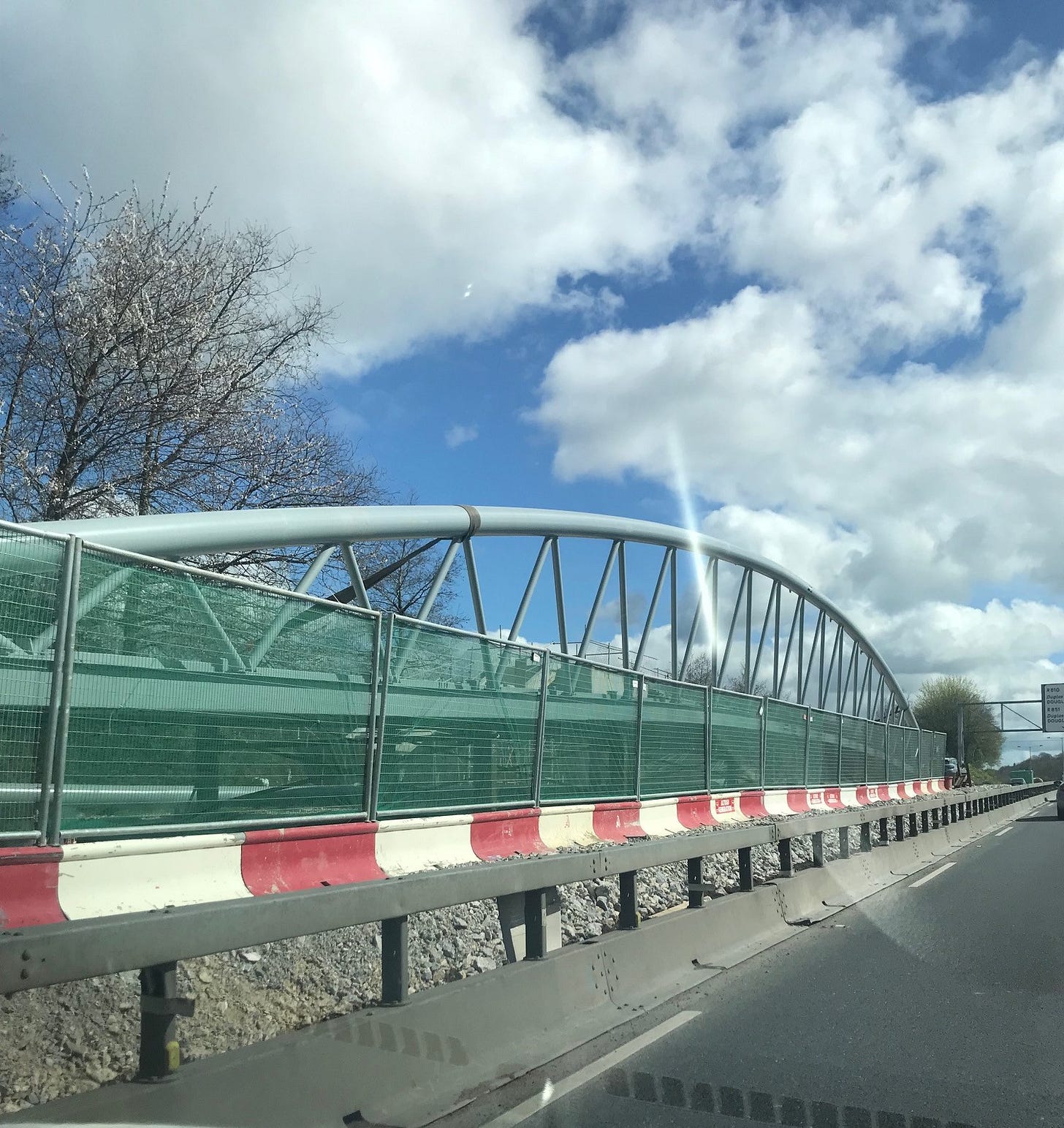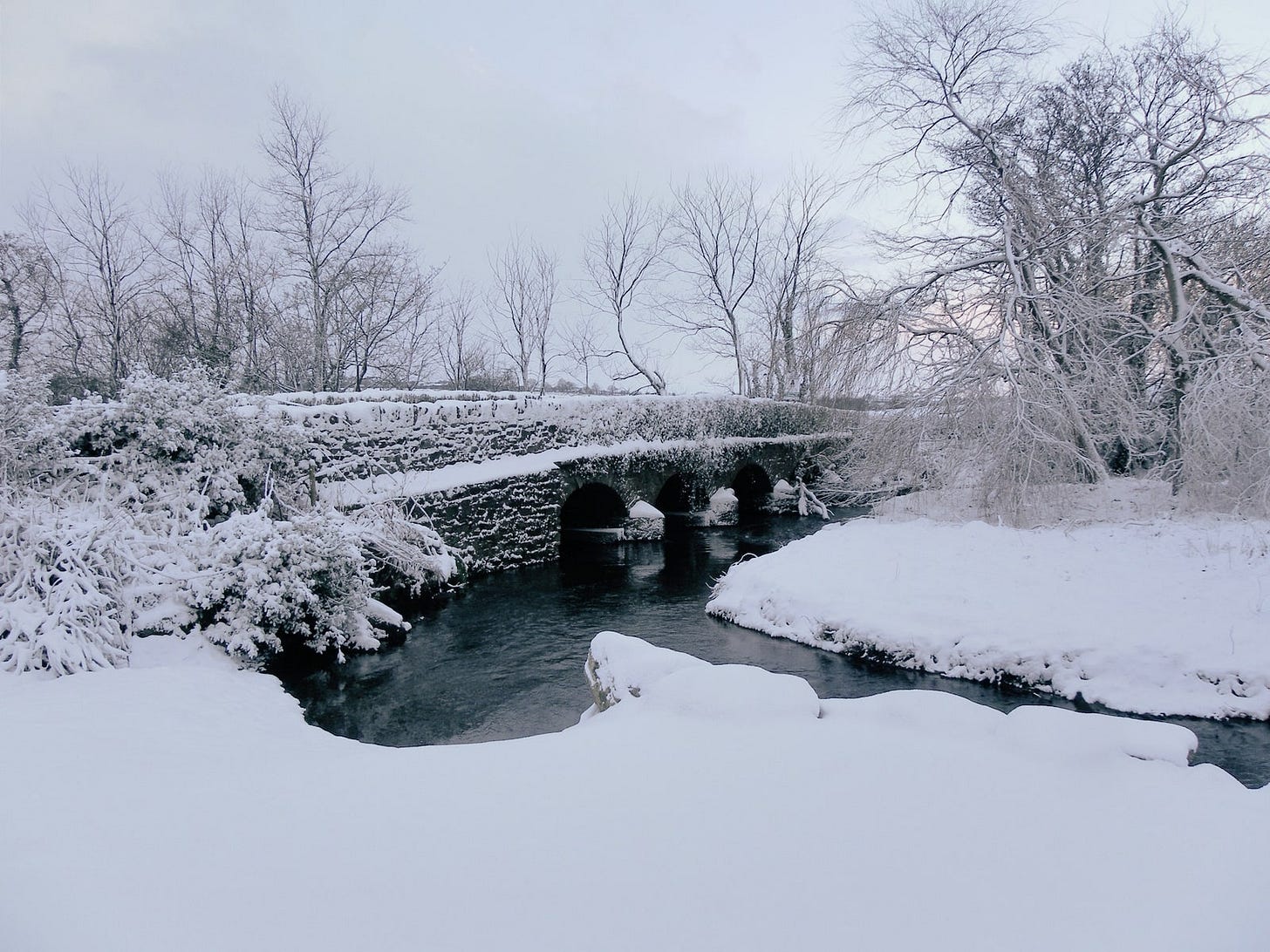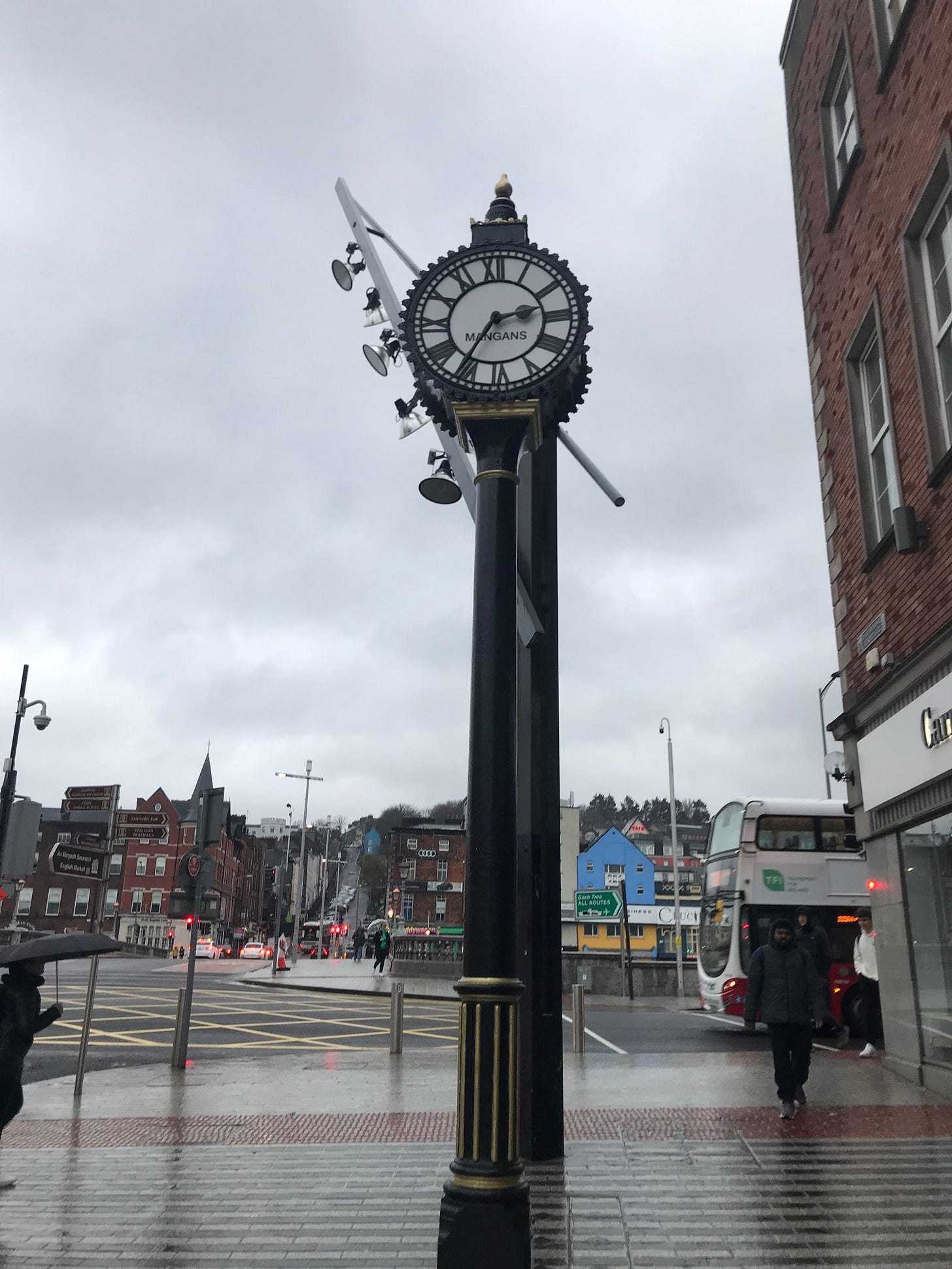The Friday View 07/04
We have two photos from our Bridges of Cork photo competition, plus a suggestion from T+D's resident historian for the name of the new bridge that will connect Grange to Tramore Valley Park.
Dia dhuit, and welcome to the (Good) Friday View from Tripe + Drisheen. Thanks for your support and do help spread the word about T+D.
The photo above by T+D reader Mary Irwin was taken in late August 2021. Mary writes: “My husband and I paddled up the South channel as far as the weir by the County Hall, and then down the North channel. Amazing seeing the city we know so well from such a different angle.”
We’ll be publishing a selection of entries from our inaugural photo competition on the theme of Cork’s bridges in The Friday View throughout April before we reveal the winner and runner-up on the last Friday. Many thanks to all who entered.
A bridge rises
In a nice bit of symmetry, we're publishing two entries from our Bridges of Cork photo competition at the same time as Cork City Council is asking the public for help in naming the new pedestrian and cycle bridge that's soon to be placed over the South Link, which will connect Grange and Frankfield to Tramore Valley Park.
It's quite the turnaround for the former dumping ground, which is now one of the city's biggest parks. The brief from the council is short and sweet: they're looking for suggestions that honor, celebrate, or remember a person, group, or events of significance that have helped to shape the City of Cork. More information can be found here.
This week, Councillor Shane O'Callaghan, FG, who has long been battling to get the bridge off the ground, tweeted his support for the name Vernon Mount Bridge.
Vernon Mount, built in the late 18th century looks down on to the Tramore Valley Park and the Black Ash. (Ireland’s ‘Big Houses’ were always looking down on something or someone!). Vernon Mount’s glory days are well and truly behind it, and it’s barely hanging in there despite the best efforts of groups such as Grange Frankfield Partnership to preserve it and its history. They’ve documented much about the house, its origins and its colourful history on their website.
Vernon Mount in Grange takes its name from Mount Vernon, the former plantation owned by George Washington, the first president of the United States. Enslaved people lived at Mount Vernon throughout Washington’s life; when Washington died in 1799 he left instructions that the enslaved population at Mount Vernon be emancipated, however not all could legally be freed as more than 150 were the property of the Custis estate, connected to the wife of George Washington’s first husband.
The US Mount Vernon was named after the British Admiral Edward Vernon. George Washington’s older half-brother Lawrence named the plantation after Admiral Vernon, whom he served under in the Caribbean. Admiral Vernon captured Porto Bello, now Panama, from the Spanish and was given the freedom of London for his efforts. Portobello in Dublin and London are named after these battles.
Back in Cork, on completion of the stately pile on a hillside in Grange, Atwell Hayes named his house Vernon Mount.
Why? Possibly, because it “was an expression of political empathy and support for the achievement of American Independence.” As the writers here note, “It could be viewed as a strange irony that the subject of the naming was himself a bastion of British colonial power.”
People are nothing if not strange. And inconsistent.
Certainly, the most infamous tenant at Vernon Mount in Cork was Atwell’s son Henry Browne Hayes, who was for a while the City Sheriff. At one stage Henry tried to sell the demesne even though he didn’t rightfully own it, rather he was badly in need of money as a result of his gambling habit. His father Atwell bailed him out in return for Henry delisting the property.
One other footnote about Henry Browne Hayes, from a long list of footnotes: in 1797, three years after the death of his wife, Henry abducted Mary Pike - her family owned Bessborough - and tried to force her to marry him at Vernon Mount. He was unsuccessful in the forced marriage, but the wheels of justice came after him and a few years later he was sentenced to death, but successfully appealed the sentence, and was instead deported to Australia.
Vernon Mount, much like Mount Vernon, fascinating as it is has a complicated and complex history and is bound up in empire, colonialism and by name association slavery.
-JJ
The case for ‘Black Ash Bridge,’ by James Furey
As we all know, our only trusted civic duty in this city is naming new infrastructure. Now, I am not against this practice. It has proved successful in the past. The Mary Elmes Bridge, for instance, has raised the profile of this local humanitarian and given Mary pride of place in her hometown. However, it is notable figures that have the monopoly on bridges.
So, we have bridges for pre-colonial figures like Brian Boru, post-colonial revolutionary figures such as Michael Collins and De Valera, Fenians (O'Neill Crowley), World War Two humanitarians in the form of Mary Elmes, religious leaders like Nano Nagle, local saints including St. Patrick, politicians including Parnell, and sporting heroes like Christy Ring. All of whom are deemed notable, worthy people.
For the naming of Cork's newest bridge, connecting Frankfield to Tramore Valley Park, I would suggest that those who lived on the land before the city's expansion through tarmacadam arteries and rubbish dumps should be honoured.
The Tramore Valley/Black Ash area is of incredible importance to Irish Travellers.
The area known as the Black Ash was a safe space for nomadic families to set up camp for generations. Many families used the site to pitch up for a few days, weeks or even months. The site served as a home, cultural centre, and place of business for those who used it. Mags O’Sullivan, from the Cork Traveller Women’s Network, says there "wasn't a Traveller family that did not pass through the site and stay at some point."
1950s Ireland saw the rise of industrial farming methods and the beginning of the ubiquity of plastics. These two encroachments of modernity quickly eradicated Travellers’ traditional means of earning money: seasonal farm labouring and tin smithing. From the 1960s, the state sought to eradicate nomadism and make Travellers "assimilate" with wider Irish society.
The state and the local authorities did not consider how these changes would affect the Travelling community. The Travellers that utilised the land around the Black Ash were further marginalised when, in the 1970s, the city saw fit to situate the new dump here. By 1980, a small section near the dump was made an "official" halting site, with restrictions. No longer would this site be open to all Travellers, with designated bays enough for just eight families.
The new dump's proximity to the community’s living space gave some Travellers access to scrap, which was reused or repurposed and sold on. But it also meant that their living conditions were affected by the noxious smells and vermin emanating from the dump.
1989 saw the Travellers being removed completely from the site, modernity again encroaching, this time in the shape of the South Ring Road.
Mags O’Sullivan talks about the deep connection between this area and the Travelling community, saying “the Black Ash is a place of preciousness and pride,” adding that the new bridge should echo that connection. Mags has plenty of names that would be suitable for the bridge, but she also says that calling it Black Ash Bridge would maintain the historical link to the Traveller camp site.
This could be an opportunity for the state and local authority to begin to make amends for the hurtful policies of the past. Relating this bridge to Travellers and how they utilised the land previously might help educate wider society about Traveller culture and traditions.
You can listen to the Black Ash Oral History Project here.
James Furey is a researcher at Béaloideas/Folklore and Ethnology in University College Cork. You can read more of his pieces for T + D here.
Bridges of Cork photo competition
Ciaran writes: “This photo was taken after a severe snowfall in 2018. Aghafantaun Bridge is a little known, but often crossed bridge that spans the River Stick about half a kilometre before the estuary in Belgooly. The bridge was built in 1850 and is a fine example of a limestone four-arch bridge, typical of the period. In spring and summer, the area around the bridge has beautiful flora such as snowdrops, herb robert, willow, alder, wild garlic to name a few, and fauna such as bats, mink, herons, ducks and trout.”
“However, the close proximity of heavily treated agricultural land means that high levels of noxious weeds have appeared in recent years. Little regard has been given to the ecology of the area as developers dug up a natural river island and replaced it with a concrete path to allow the water to move freely. Hopefully the natural ecosystem will eventually recover.”
News in Brief
Surprising no one really, Cork City Council informed councillors this week in a one-line email that a “location for the proposed Michael Collins Statue has been agreed at the Grand Parade and advised to the Collins Committee.” That was the full extent of the big reveal that some local media were trumpeting. As for where exactly on Grand Parade and when, well, we’ll have to wait. But the 'Big Fella' is coming to Grand Parade.
Further north, at the top of St. Patrick’s Street where it meets Merchant’s Quay, Mangan’s Clock has been refurbished, repaired, and repainted. However, it’s still a stopped clock (cue stopped clock jokes). T+D asked Cork City Council if they have a timeline for when it will be back ticking. As of publishing, we are still awaiting a response.
Cork Lifelong Learning Festival wrapped up last weekend. They have a very short survey here, which they are asking anyone who attended to kindly complete.
Out + About
Hollow Earth, an exhibition by the Hayward Gallery, opened this week at the Glucksman. The singular theme is caves, but as the Guardian reviewer wrote of the exhibition, “everything from lava paintings to cave perfumes via ceramic grenades feature in this exhibition: a glorious meditation on geology, early art and shamanic visions.” More information here.
Time, date, place: until July 9, Tues-Sat, 10am - 5 pm, Sunday 2-5pm, UCC
Over at Laneway Gallery in Shandon, Conversations with the Landscape features the paintings of Tiffani Love and Rachael Johnson. Love’s paintings explore the coastal terrain of Ireland's Wild Atlantic Way, while Johnson’s work takes the bogs and shoreline of Derry as their starting point. The opening night is this Saturday, April 8, and patrons are invited to drop in between 6pm-9pm. More information here.
Time, date, place: 11am - 4 pm, Tues, Thurs, Frid-Sat, Laneway Gallery, 120a Shandon Street
Residents of Blackrock will meet this Saturday morning at Blackrock Castle from where they’ll spread out around area to clean up the public amenities. New volunteers welcome. Refreshments after in the castle.
Time, date, place: 10am - 12pm, Saturday April 8, Blackrock Castle
This week on T+D
On Monday, Ellie wrote about a Cork City Council meeting on preparedness to deal with an anticipated surge in homelessness. The meeting was bizarre because no sooner had it started than it ended. More here.
On Tuesday, JJ wrote about new plans for a greenway in Blackpool which would see a section of it run atop a culverted section of the River Bride. It’s still not clear when the flood relief scheme will start in Blackpool and what shape it will take, but what is clear is that the proposed greenway is divisive. Full story here.
On Wednesday, JJ wrote about the launch of Ballydehob Jazz Festival. A mighty crew from West Cork took over Cask bar on MacCuratin Street for the launch of the festival, now in its 17th edition. It runs over the May bank holiday. Full story here.
On Thursday, Alisa Salenko, a Ukrainian journalism student, returned to write for Tripe + Drisheen. Alisa wrote for T+D around this time last year when she detailed her experience of arriving in Ireland to stay with a Cork family. A lot has changed for Alisa in the past year. You can read about her journey in Ireland since then here.
On Thursday, we also wrote about the two UCC students who are tackling the accommodation crisis in Cork city. JJ spoke to Peadar Ó Rathaille, who, along with Brian O’Kane, is filing hundreds of complaints to the City Council's planning department over property owners violating short-term rental laws. Full story below:
That’s it for this week’s Friday View. Any tips, news or events you’d like to share with Tripe+Drisheen, you can contact us via our About page here. We are always happy to speak to people off the record in the first instance, and we will treat your information with confidence and sensitivity. Get in touch. Have a lovely weekend.










